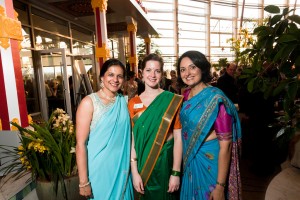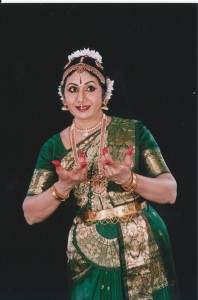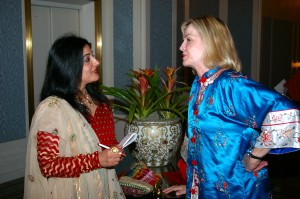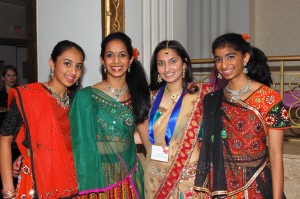Archive for category July 2010
Phipps Unfurled Tropical Forest India in Colorful Gala in March
By Meena Mutyala, Fox Chapel, PA
Meena Mutyala grew up in Nagpur, India, went to IIT Madras and then to graduate school at Northwestern University. She also obtained her executive MBA from the University of Pittsburgh. She and her husband Brahmaji are long-time residents of this area and have two adult children. She works in a large international company in Pittsburgh. Note: The pictures in this story are from Renee Rosensteel.
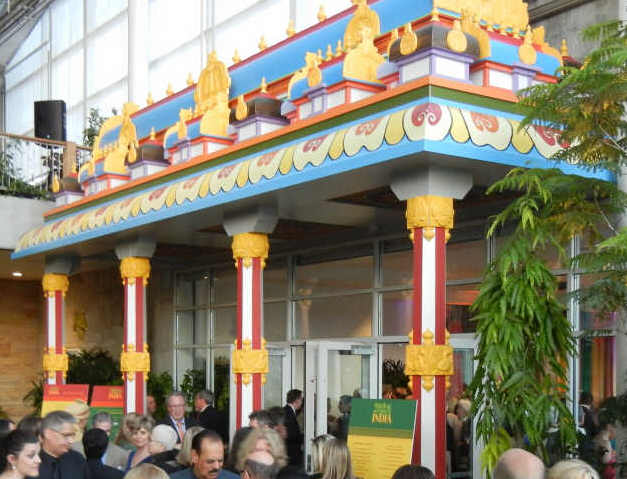
The facade of a typical South Indian Temple created by Sthapati Ayyachami Narayanan of Penn Hills at the Phipps Tropical Forest India Exhibit.
Saturday, March 17. The temperature was in the 70s and humidity pleasantly low. The orÂganizers at Phipps Conservatory could not have asked for a more pleasant day for the inaugural gala for unfurling The Tropical Forest India, the 3-year-long live exhibit. An overflowing number of nearly 400 people — trustees of Phipps, Phipps officials, patrons, volunteers, and others, among whom were a large number of Indian-Americans — gathered under the canopy of lush tropical plants of India with the sights, sounds, aroma and the bustle of an Indian celebration. Rangoli at the entrance creÂatively done with toor dal, masoor dal and rajma beans; delicious fusion food; music; tasteful Indian decorations and tapestry and decorations — all amidst exotic Indian plants — created an ambience that was truly unique and special.
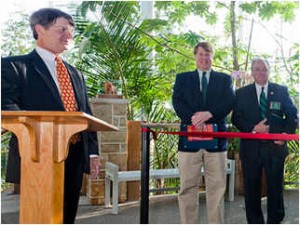
During inauguration L to R: Phipps' Richard Piacentini, Allegheny Co. Chef Executive Rich Fitzgerald, and Penna's US Congressman Mike Doyle.
 This exhibit was planned for over two years with Ben Dunigan and Jordyn Melino, the two horticulturalists at Phipps, traveling to India in 2010 and spending weeks in the lush Western Ghat region. Since then, they have devoted themselves to Tropical Forest India from the design phase through the installation and the grand opening. The researching of the plants and obtaining the special plant species from the Western Ghats and the Himalayan/Assam region has been their passion. They also took the lead in the overall décor of the exhibit. Jordyn came to the event on March 17th in a green Kanchi saree — appropriate for St. Patrick’s Day on that Saturday and for an Indian celebration!
An ornate entrance in the form of an Indian temple façade led the guests into the Special Events Hall. This richly colorful entrance was created lovingly by our own SthaÂpati Ayyachami Narayanan (who did most of the decorative sculpÂtural work and the repair work on the towers at the S.V.Temple) working closely with Dunigan on the design and colÂor scheme. The ceiling of the Special Events Hall is painted with elaborate murals patterned after the Madurai palace ceilings by the Pittsburgh-based Indian-American artist, Francis Cleetus.
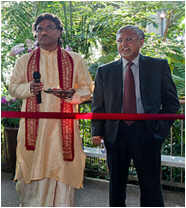
Pandit Vinod Kumar Pandey from H-J Temple reciting Sanskrit hymns during the opening ceremony with Pramod Bajaj from New York Indian Consulate standing beside him.
For both Narayanan and Francis, this was a unique opportunity for showcasing India’s visual arts to all those visiting Phipps during the next three years. They worked enthusiastiÂcally for two months and the result is spectacular. With its grand entrance, the Special Events Hall is going to be a perfect place to rent for private Indian events.
The Honorary Chairs of the Gala Event were Krishna and Om Sharma. Vijayalakshmi MadÂhavan provided a veena recital with Johnson Kottakalil Paul (a disciple of Pt. Keshab Kanti Chowdhury of Delhi Gharana) providing laya (percussion) support on the tabla. There was also a classical Kathak recital by Varun and Sonia Mahajan, and Bhangra dancing.
As the night moved on and we had our fill of interesting conversations, great food and drinks, many – including several from Mainstream USA — got into Bollywood dancing!
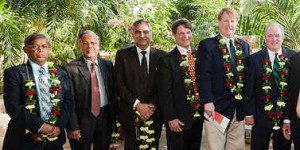 L to R: Sthapati Ayyachami Narayanan; Pramod Bajaj from the Indian Consulate in New York; Rajiv Malik, President Mylan Inc.; Richard Piacentini of Phipps; Rich Fitzgeral, Chief Executive of Allegheny Co.; and Penna’s US Congressman Mike Doyle during the inauguration.
L to R: Sthapati Ayyachami Narayanan; Pramod Bajaj from the Indian Consulate in New York; Rajiv Malik, President Mylan Inc.; Richard Piacentini of Phipps; Rich Fitzgeral, Chief Executive of Allegheny Co.; and Penna’s US Congressman Mike Doyle during the inauguration.
The gala opening event and the overall exhibit gave me a sense that the Indian American community and Indian culture and traditions have become an integral part of the Pittsburgh arts and cultural scene. As Ritu Thamman, one of the members of the planning committee, put it, “I feel so proud that this has happened in Pittsburgh and we can showcase Pittsburgh and India for the next three years.â€
Phipps Executive Director Richard Piacentini was effusive in acknowlÂedging the work that has gone into this project: “In addition to the efforts and creative vision of the forest curator Ben Dunigan, program specialist Jordyn Melino and other staff, a tremendous amount of talent, knowledge and support from Indian communities in Pittsburgh and abroad went into plans for Tropical Forest India.â€
Greg DuFour, Director, Development Campaign at Phipps said, “It is our hope that this unique exhibit celebrating one of the most precious natural areas on earth will captivate visitors with its beauty, inspiring them to explore the many ways we can all help promote biodiversity with the choices we make every day.â€
Make it a point to get out to Phipps and see the 12,000 square feet of Indian ethnobotanic displays and also the cultural and educational programs that highlight the people, culture and flora of India in all its diverse splendor.
And when we have out of town guests, let us show off Phipps — the glass jewel of Pittsburgh and the world’s most energy-efficient greenhouse that now houses the splendid Tropical Forest India exhibit.
Acknowledgment: The graphics in the stories are by Renee Rosensteel. ï®
Breast-feeding is Priceless
Manjari Manoharan Kulkarni is a native Pittsburgher. She lives in Manhattan with her husband Rajiv, daughter Leela and dog Indiana. Manju enjoys practicing/teaching yoga, learning philosophy, eating healthy and reading. She is an orthodontist in New Jersey and enjoys making people smile!
When we discovered we were expecting, my husband and I were thrilled. To prep for the pregnancy and labor we read volumes and attended intense birthing classes. Nine months flew by and before we knew it – Baby!
However, no one told us about what happens after the baby comes. My obstetrician did allude to it when he asked if I wanted to breast feed. I simply shrugged “Yes,†and with no further information was shuffled on to the ultrasound. How I wish I was forewarned!
Breastfeeding turned out to be anything but simple. My vision of Yasoda seeing the Universe in her child’s mouth was swapped with thoughts of failure as my frustrated baby cried out in hunger. After multiple failed attempts, even our pediatrician suggested I skip directly to formula. After all, most Americans in the 1970s were raised on formula and we all turned out fine, right?
I naively believed that breast feeding would be instinctual. Evolution would prevail and baby and I would figure it out. But, years ago women learned from peers. All I witnessed was a covered woman with a baby underneath. What was going on under there?
Today’s reality is that expecting moms are bombarded with advertisements and free samples for formula. The tag lines on formula containers read “Breast milk is best, but for those that can’t, formula is almost as good.â€Â Formula was an instant solution to my problem.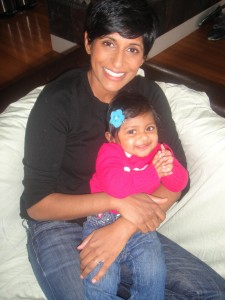
Fortunately, my instinct told me not to give up. Searching for help, I found a lactation consultant. She visited my home to teach me proper positioning and encouraged me. I joined lactation clinics where I commiserated with other breast feeding challenged moms. And, I rented a hospital-grade breast pump to help boost my milk supply. In the initial weeks the physical pain and sheer exhaustion of breast feeding made child birth feel like baking cupcakes. But, after truly appreciating the benefits of breast milk, it was worth the effort. And it got easier.
Moms refer to breast milk as “liquid gold,†not just because of the effort it takes to make a few ounces, but also due to the following benefits, among others:
- A 2004 study in Lancet showed that breast fed children have 14% lower cholesterol as adults
- Another 2005 study in American Journal of Epidemiology tells finds that children who are breast fed for at least 9 months have 30% less risk of obesity.
- Breast milk contains antibodies that are passed from mother to child to help build immunity resulting in innumerable benefits
- In 2007 the American Institute for Cancer Research showed reduced risk of breast cancer in both pre and post menopausal women who breast fed for at least six months
So starting children off with breast milk gives all of us the best foundation for good health. Talk about true health care reform!
As a working mom, I invested in a portable breast pump and supplies. These items were costly, but relative to the health of my child, money well spent. In addition, employers benefit from accommodating breast pumping. Babies that are fed breast milk are healthier, resulting in a happier mom with fewer days off.
From an environmental standpoint, breast milk is locally grown (!) and has no waste when compared to the demands of producing and distributing formula. Breast feeding is an effective way for humans to reduce our carbon footprint, right from day zero.
Ultimately, the key to successful breastfeeding is a rock-solid belief in the benefits. Having a supportive husband helps too!
Remember these:
Breast pump: $$$$. More groceries for mom’s increased appetite: $$.
Lost Hours of Sleep: Too many to count. Benefits to Baby and Mom:Â Priceless
To learn more about breast feeding, benefits, and resources, visit the La Leche League website: LLLi.org.
The NRI Broadband Basketball in India
 By Prashanth Krishnamurthy, Pittsburgh, PA     e-mail:  prashk@gmail.com
Originally from Bangalore, India, Prashanth Krishnamurthy has been a Pittsburgh resident for the last ten years. He teaches telecommunications at the University of Pittsburgh and feels severely handicapped when he does not have Internet access.
India has made significant advances in wireless communications in infrastructure and availability, and India’s relatively inexpensive IT giants are smoothening things for the English-speaking developed world through their tech service and call centers. But nonresident Indians visiting India for short spans, like a month or less, face unexpected, often unbelievable, and sometimes hilarious hurdles for getting wireless broadband Internet access right in their front yard. This, even in a place like Bangalore, arguably India’s IT capital (though Chennaivasis and Hyderabadis may contest that claim). Â
Those with relatives that already have broadband Internet access or have relatives willing to be frontmen for getting the broadband access have few problems. In other words, you better have a deep bench. Try getting it on your own, you will most certainly have an entertaining experience at the bare minimum.
My spouse and I arrived in Bangalore for a month and had no one readily available to be frontmen for us. We knew of and had seen ads touting the great benefits of Reliance’s NetConnect wireless broadband Internet service. So our first stop was at a Reliance store in Jayanagar, a well-known Bangalore suburb. We had to dribble the ball there for almost two hours.
While the NetConnect service is supposed to have both a prepaid option (pay up front and as you go) and a postpaid option (bill me every month), mysteriously, the prepaid option was not available — “sold out to college students†— claimed the gentleman there. We were antsy about the postpaid service, which “could not be cancelled†for three months. Now, who would pay the bills after we left India in a month? After several discussions with the quite friendly folks there, we discovered that we could “suspend†the service before we left or “convert it to a prepaid†option. Deciding to take the chance, we asked for the USB card and service.Â
But they needed my passport photograph and a proof of residence in India and asked me to fill a few forms. It was then that our salesman made a blind pass of our forms to another person resulting in a blocked shot. My passport (which had both our US address and my father’s Bangalore address) had been issued by the Indian embassy in NYC and the information was not “printed†but handwritten. This caused an insurmountable problem for the folks at Reliance. They could not trust my passport. My spouse had a passport with printed information and I thought that would be acceptable. In her passport, the Indian address provided was in Chennai. Nope. That wouldn’t work in Bangalore.
“Three more days and we can try to see if someone higher up can approve your handwritten passport,†said the gentleman at Reliance. And there ended the halftime.
The other service provider we had heard of and checked with next, Bharti Airtel, turned out to be Bharti ‘Airball’. Their wonderful service “promised†us 3G “whenever†it would become available. And “whenever†was perhaps six months away. Till then, you had to live with the crawling 115 kbps on the downlink. We did not bother showing my handwritten passport here.
We finally had our first field goal with Tata Indicom’s Photon service — postpaid but with an option to cancel after a month. They had no issues with my handwritten passport. But they still threw a screen – someone had to come to my father’s house (local address in Bangalore) to verify that I was living there! They did that a couple of days later. Fortunately I was around at home then. Otherwise, they might have stopped the service.
A month passed and we were pleased with the service. The time to cancel the service had arrived, but was this an issue! When we called, they told us they would cancel it “right away†only if we went to their head office in Koramangala – thirty minutes by auto from where I lived. But, when we did reach there through Bangalore’s traffic jam, they would NOT cancel it right away. They wondered why we were canceling in less than a month. Were we unhappy? Can we send an e-mail to their customer-care to cancel it?
 And two months later, the service was still not cancelled, but the very “concerned†folks at Tata Indicom are working hard to oblige. We are now in overtime.
Randy Pausch’s Last Lecture in Telugu
A Review by Anurajya Lakshmi Dittakavi, McDonald, PAÂ Â e-mail:Â anuraja37@hotmail.com
Anurajya is from Andhra Pradesh, India. In 1978 she reached the US. In 1982, she and her husband Naga Sharkar Dittakavi went to Nigeria on an one-year teaching assignment. Anurajya’s specialty is HR-related issues in the IT industry. Along the way, she also earned a masters degree in management from CMU. She is a certified HR professional heading HR department in an IT company in Pittsburgh.
Prof. Randy Pausch’s Last Lecture — Telugu translation by Sri Lakshmi Polam Reddy. Published by arrangement with Hyperion Publishers (230 pp). For copies contact sreepr@gmail.com
Randy Pausch was a professor in computer science and computer-human interaction at Carnegie Mellon University when he was diagnosed with pancreatic cancer in the fall of 2006.
The university has an ongoing lecture series under which top academicians are asked to “think deeply about what matters to them, and then give a hypothetical ‘final talk’ on what wisdom would [they] try to impart to the world if it was their last chance.†In September 2007, Pausch delivered his “Last Lecture†titled Really Achieving Your Childhood Dreams.†In the lecture peppered with humor, Pausch stresses that one needs to have fun in life while living life to its fullest because one never knows when it is snatched away from you. This lecture, when published as a book, became a runaway best seller.
I did not read The Last Lecture fearing it would emotionally drain me out. Recently, Sri Lakshmi Polam Reddy, a Pittsburgh resident, inspired by Pausch’s background and his message, has rendered the book in Telugu. Reddy has published the book from her own resources.
Sri Lakshmi Polam Reddy shows to Telugu-speaking people the journey of Prof. Randy Pausch, who strived to fulfill most of his dreams in the short span of his life. This book made me revisit my own childhood dreams where I left them off a long time back, while busy making amends, adjustments, compromises and sacrifices to my own journey in life.
Most of our journeys in life are toward unknown destinations often without a timeframe, whereas Professor Randy Pausch’s life was with a few more scary facts: In 2006, he was diagnosed with a deadly form of cancer in his pancreas, and in 2007 he was told that he had only three to six more month to live. Prof. Pausch made every bit of his short journey ahead worthwhile till he reached his destination – his death.Â
In this book, Sri Lakshmi’s Telugu is so fluid and precise that one never feels it is a translation. She is so facile with her Telugu that she makes it look simple. Telugu readers will be inspired both by Pausch’s life and Sri Lakshmi’s efforts to retell his story in Telugu.Â
As you leaf through the chapters of this book, the author leads the readers to their own dreams and achievements. The Last Lecture is about childhood dreams on “How to make your Childhood Dreams a reality?â€
Takeaways from this lecture Prof. Pausch father’s suggestion: “Do not take a decision unless you need it desperately.†Prof. Pausch’s request to other parents is to “let their children paint their rooms (give the liberty).â€Â
Pausch knew how far he wanted to go while he was a kid, and he never gave up on anything that he had set his mind on. His efforts to go on the Space Shuttle prove this point. He did not think twice to resign from his faculty adviser position just to gain the space shuttle experience.
Pausch implores people to pay attention to “primary principles†in life. If someone is pushing you to do something right, he says, it is because he or she saw potential in you and they want you to be successful.
Pausch realized Coach Grahm’s advise to work hard on things that were difficult — that effort led him to be successful sometime later in life.
Along the way, here are some of the gems from Pausch:Â
“Brick walls are there for a reason: they let us prove how badly we want things.â€Â
“Always speak the truth.â€
“Don’t say sorry unless you mean it.â€
“You need not fix everything that is damaged.â€Â
“Do not complain, just work hard.â€
“Observe what others are doing — not what they are saying.â€Â
“Victory should not be the aim but do not accept the defeat.â€Â
“Showing gratitude is simple – send hand written thank you notes.â€
Translation is always a work of inspiration, particularly when it is done in one’s spare time. Sri Lakshmi’s passion for Pausch’s message comes right through in the translation. We only hope Srilakshmi would find some more treasures like these to bring to Telugu readers.
Meals On Wheels Helps People in Need
By Manjula Vasant Germanwala    Â
Manjula Germanwala grew up in Mumbai, India. She lives in Greentree for over thirty-five years. She is active in many cultural and social organizations.Â
The organization is called Meals On Wheels (MOW). How did it get this name? In 1939, during World War II, the Germans bombed England. Many people became homeless. So a group of women volunteers responded by preparing and delivering meals to their disadvantaged neighbors. These women also brought refreshments to servicemen during the war. This group eventually became known as Meals on Wheels, the first organized nutrition program for delivering food.
The Lutheran Service Society (LSS), the largest provider of this type of service in Western Pennsylvania, brought the MOW concept in the Tri-state area in 1968. This organization, through its volunteers, strives to provide independence and dignity to the homebound elderly and disabled people by delivering two meals during the weekdays directly to their homes. They even try to accommodate individual special dietary needs such as low sodium, diabetic, and low cholesterol diets.
MOW takes place in our neighborhood churches. They have a special cook who follows the LSS rules and regulations according to the meal plan. Some volunteers provide the service of packing food and work in the kitchen. Other volunteers deliver the food and are on the road.
Volunteers working for Meals on Wheels help in many ways: Working in the kitchen, informing people that the kitchen is closed in inclement weather, delivering the food, and donating fruits, cakes, cookies, etc. to the people in need.
How did I get to join the group? I worked for a commercial book store for many years. I felt it was like a Saraswati Mandir. Once I had a customer who used to volunteer for MOW. She gave me lots of information about this altruistic group.
When my bookstore closed down due to a business decision, I had lots of time on my hand.  One day I went to a church where they were providing a MOW program. The manager was searching for volunteering help, specifically with delivering food two days per week. This was convenient for me. I went on my assigned days and met my driver, a sweet person, who was also retired. Over the last four years, I started helping in the kitchen. I also go to other churches which have similar programs and deliver additional food.
This kitchen is run professionally taking all the precautions and care for preparing nutritious food hygienically. Once a year, there is even a party for the volunteers!
Working as a volunteer for MOW, I have come across so many good people. I made some new friends, especially when I deliver food. I met many senior citizens who are so eager to tell you their problems. I listen to them very quietly. We laugh and we cry together.
MOW delivers two meals to each individual at a time. One is in a brown bag which contains milk, juice, fruits, sandwiches, cookies, and other snacks I also include copies of short stories for them to read while eating. They love to read. The other box contains a hot meal made with meat, vegetables, and a side dish. The kitchen staff makes sure that the meal is well balanced.
When the weather is really bad, we occasionally provide an extra meal in anticipation with nonperishable items which is called a storm kit. When I come home, I feel very happy for doing something good.
I love to be in contact with people. I hope Providence gives me the strength to do good work for many more years. It takes only about five hours per week. I wish we can have a similar program for our Indian community seniors. I am afraid, we may be approaching the situation in which we will need an organization like this for the Indian community.Â
When we do something good for others we feel good. Working week by week, these individuals and even the volunteers become a part of you. Once in a while my son Anand and my granddaughter Arya join me in delivering food.
If anyone wants to know about volunteering to Meals on Wheels, here are the contact details:
The Lutheran Service Society of Western Pennsylvania
3171 Babcock Blvd.
Pittsburgh, PA 15237-2737
Website: www.lsswpa.org    Phone: 412-366-9490
Cardiologist R.G.Krishnan Receives Award
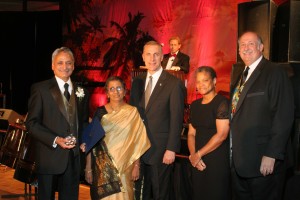 R.G.Krishnan, a cardiologist, known as Gopala Krishnan for many of his friends, received the Sickman-Levin Award for Dimensions in Medicine at the Monongahela Valley Hospital’s 22nd annual gala on May 22 at the Westin Convention Center and Hotel in downtown. The award was instituted in 1988 honoring Albert Sickman and Herbert Levin, both physicians, for their contribution to healthcare in the Mon Valley.
R.G.Krishnan, a cardiologist, known as Gopala Krishnan for many of his friends, received the Sickman-Levin Award for Dimensions in Medicine at the Monongahela Valley Hospital’s 22nd annual gala on May 22 at the Westin Convention Center and Hotel in downtown. The award was instituted in 1988 honoring Albert Sickman and Herbert Levin, both physicians, for their contribution to healthcare in the Mon Valley.
Mr. Luis Panza, the CEO of the hospital, said in a press release, “Dr. Krishnan certainly symbolizes the qualities at the heart of the Sickman-Levin Award. His commitment to heathcare and cardiology goes far beyond direct personal care. His years of untiring service… … make it most appropriate that Dr. Krishnan receive this award. [He] … epitomizes the true meaning of helping others and the ideals of the medical profession.â€
After completing his medical degree at the famous Madras Medical College in Chennai in 1970, he finished his internship in 1973 in a hospital in Yonkers, NY; his residency in a hospital in the Bronx in1976; and his cardiology fellowship at St. Francis General Hospital in Pittsburgh in 1978.
Since his appointment to the Medical Staff at the Mon Valley Hospital in 1978, he has served the hospital in different capacities, including as the current president of the medical staff, vice president from 2004-08, and director of coronary care and progressive care unit, among others. Since 2002, he is member of governing body of the Mon Valley Health Resources, the parent company of the hospital. Krishnan also received the special Congressional recognition during the gala from Rep. Murphy.
Married to Jyothi for 34 years, the Krishnans live in Venetia, PA, and they have two grown-up sons and a daughter.
Indian Healthcare Providers Discuss Healthcare Issues
By Rashi Venkataraman, Murrysville, PA
On April 18, over two hundred physicians gathered for their annual TAPI (Tristate Association of Physicians of Indian Origin) meeting in Coraopolis at the Embassy Suites. As part of the meeting, they had several lectures – Yoga in treating psychiatric disorders, diabetes among Indians, irritable bowel syndrome, among others — to keep themselves up-to-date. Â
TAPI also invites pharmaceutical companies to set up booths to promote their new prescription medicines. This also helps TAPI to defray the cost of organizing their meeting. Events like the TAPI Annual Dinner, as one of the drug company representatives told, “are beneficial in that it brings all physicians in one place to talk about new advances in their field.â€
With all the changes taking place in the healthcare industry, it is an interesting time for physicians nationwide, to say the least. Several segments of the industry, including healthcare providers, are anxious about the future. One physician went as far as to declare at the evening’s dinner, “Medicine is in a state of peril.â€Â
In Pennsylvania, with an aging population, two main concerns over the healthcare legislation are the shortage of primary care physicians and the threat of rationed care as a result of cuts to Medicare.
The keynote speaker was Sanford Kurtz, the Chief Operating Officer for the West Penn Allegheny Health System. In his speech on “The Future of Health Care in Pennsylvania,†Kurtz said that moving forward, it won’t be difficult for physicians to accept new ideas. “The hardest thing, instead,†he said, “will be forgetting old ideas.†Kurtz raised his concerns over rising health care costs, shrinking investments in research & development, and the impact of Information Technology in all aspects of healthcare delivery and management.Â
N.S.Srinivasa, president of TAPI, introduced the keynote speaker to the audience.
Good News! Indians are not a “Minorityâ€
Recently Carnegie Mellon University published in their in-house publication Focus (Vol. 21, No 8, Spring 2010) some statistics around the demographics of their student body and staff. Race and gender being dominant parts of social discourses in the US, the stats were broke down along race and gender:
Male/Female Ratio                 % Blacks,  Hispanics
Native Americans
Tenure-track Faculty: Â Â Â Â Â Â Â Â Â 77/23 Â Â Â Â Â Â Â Â Â Â Â Â Â Â Â Â Â Â Â Â Â Â Â Â Â Â Â Â Â Â Â Â Â Â Â 4%
Other Staff:Â Â Â Â Â Â Â Â Â Â Â Â Â Â Â Â Â Â Â Â Â Â Â Â Â Â Â Â Â Â 46/54 Â Â Â Â Â Â Â Â Â Â Â Â Â Â Â Â Â Â Â Â Â Â Â Â Â Â Â Â Â Â Â Â Â Â Â Â 6%
Undergraduates:Â Â Â Â Â Â Â Â Â Â Â Â Â Â Â Â Â Â Â 59/41Â Â Â Â Â Â Â Â Â Â Â Â Â Â Â Â Â Â Â Â Â Â Â Â Â Â Â Â Â Â Â Â Â Â Â Â 11%
Graduate students:Â Â Â Â Â Â Â Â Â Â Â Â Â Â 70/30 Â Â Â Â Â Â Â Â Â Â Â Â Â Â Â Â Â Â Â Â Â Â Â Â Â Â Â Â Â Â Â Â Â Â 4%
Notes: Blacks and Hispanics in the US form 23% of the population. At CMU 15% of undergraduates and 48% of graduate students are international.
Interestingly, CMU has grouped Asians (including Indians) along with majority Whites in the racial mix of the university body:
Tenure-track faculty:Â 91% White and Asian American
Other staff: 87% White and Asian American
When contacted, Ms. Janel Sutkus, Head of Institutional Research at CMU, told The Patrika that in the context of the demographic makeup of the nation’s population, people of Asian and Indian heritage are not under-represented in the CMU community; but women, Blacks, Hispanics and Native Americans are. That is why the university has not been classifying Asians — Chinese, Koreans, Japanese and Indians – as not minorities.
Well, simply walking along the campus, we can even speculate that these Asians are over-represented in the university’s demographics. This grouping of Asian- and Indian-Americans along with Whites is a trend what we will see more and more in other walks of life in the future.
In the American context, Indian-Americans may be a minority in numbers, but bulk of us come from what can be only called a “privileged†minority: Because of skewed immigration, a large proportion of us have better education and/or entrepreneurial skills, hence higher earnings and net worth than the national average. We give our children stable homes – so critical for their growth socially and psychologically in their formative and later years — even though most of our marriages may not be the happiest ones. We endure in our marriages for the sake of our children.
As Indian-Americans, coming out of the minority classification ought to be liberating at one level. It’s an affirmation of how far we have come since the Asian Exclusion Act of 1924. Going forward, the concept of Affirmative Action and Equal Opportunity Employment are going to be irrelevant for most of our children.
But this puts the children of gas station attendants, taxi drivers, restaurant cooks and others of Indian origin at a great disadvantage. To address this inequity, educational institutions need to look at the 1040 forms of the parents of Asian students before deciding on financial awards. This is one way to give a break to college applicants coming from socioeconomically disadvantaged homes – whether white, black, brown, and yellow.
Going forward, we are going to be judged, to quote Dr. King, “not by the color of our skin [or other features], but by the contents of our character,†to which we may also add, our intellect, skills, and how we respond to our social obligations here in the US going beyond paying taxes.
This is enough motivation for us to give back to society what we have received from Providence and from this land of opportunity.
Boyd Community Center Celebrated India
 Jennifer Schaupp, Program Director  e-mail: jenniferschaupp@gmail.com
Boyd Community Center
1220 Powers Run Road, Pittsburgh, PA Â 15238
412-828-8566 x24Â Â
On Sunday, March 21, the Boyd Community Center in O’Hara Township hosted its second celebration of Indian culture with a wide variety of activities. Thanks to the support and planning efforts of diverse community volunteers and Boyd staff, the event showcased the beauty of Indian arts and traditions and raised money for the Center.Â
The event kicked off with a film talk and screening of If It Ain’t Broke, Break It by Pittsburgh filmmaker Dr. Ravi Godse. The evening continued with yoga, breathing, and meditation demonstrations from community members and Boyd instructors, including Moni Wesner, Krishan Aggarwal, and Anjana Vijayvargiya.
The lineup of dancing and music began with the Kuchipudi dances of Kamala Reddy and her students and followed with the Bollywood and Bhangra inspired dances of Ruby Jain (also the emcee of the event) and her students. Then followed the Bharatanatyam and folk dances and music performances of Sanskruti School of Indian Dance and Music, and the Bhangra moves of Shivum Bharill.
The festivities continued with a song from Darshana Menon, musical instrument performances by Shivum Bharill and Sameer Kumar, the lively steps of Steel City Bhangra, and the classical, folk, and contemporary dances from Nandanik Dance Academy. And the culminating dance moment that brought people to their feet was Ruby Jain’s audience participation number!
Amidst the music and dance was a pleasing addition this year – the “how to wear a sari†demonstration and the sari and Indian garment sale, led by Vandana Kekre.
Throughout the Celebrate India event, the visitors enjoyed the delicious chicken and vegetable curry dishes from Taj Mahal Restaurant and the sweet treats and fruits from community member and cook Sajeda Kamal.
People could also purchase stunning jewelry from Harshita Gurnani, view slides from a Boyd staff member’s trip to India, and peruse Indian themed library books and a literary journal, a magazine, and a children’s book, all by Indian authors and editors. Children found enjoyment in the button making activity, led by Boyd’s after school instructor Alison Zapata and student Amelia Porter Bacon, and also the henna tattoos of Indu Aggarwal and family and Hindi name art with Sunder Kekre.
To add to the ambience of the event, Mahendra Shah displayed his famous cartoons, and Indian tapestries and posters of famous Bollywood actors hung on the walls of the Boyd gymnasium. Finally, the night ended with the raffling of names for assorted donated items, including tickets to Dr. Ravi’s film, a sari, a pendant, and a fresh fruit basket.
The publicizing efforts of The Pittsburgh Patrika and Deepali Zende of WRCT’s “Bombay in My Soul,†among others, helped spread the word and make successful Boyd’s Celebrate India event.
I welcome interested community members to contact me at 412-828-8566 x24 if they want to assist with the planning of next year’s India celebration.
Arts Foundation Honors Dance Teachers
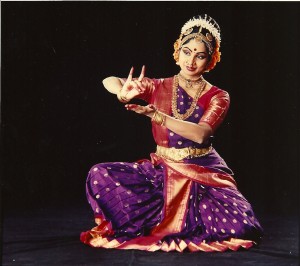
Kamala Reddy
By Radha Rao Dhulipala, Fox Chapel, PA    e-mail: dhulipala1@hotmail.com   Â
Radha Rao Dhulipala, a long time resident of the Pittsburgh Metro area, was Born and educated in Chirala, Andhra Pradesh. She arrived in the US in 1966. She has been active at the SV Temple since its early days. She and her husband Madhu Rao live in the Fox Chapel area.Â
Srinivasa Paada Ghantika (Dancing Bells on Srinivasa’s Ankles), a collaboration of North American Kuchipudi artistes, presented Premanjali at the Sri Venkateswara Temple auditorium on Saturday May 1st, 2010.
Premanjali – meaning A Loving Memorial Tribute in Sanskrit – was organized in memory of Srinivasa Prasad Gutti, known simply as Vaasu to his large circle of friends. Vaasu was an ardent lover of performing arts whose passion was to propagate Kuchipudi dance and Karnatic music among North American youth. While returning after a dance recital, his life was tragically cut short in an auto accident in 2004. He was 22.Â
To fulfill Vaasu’s wishes, his parents Varaprasada Rao and Parvathi Gutti established The Srinivasa Prasad International Foundation for the Performing Arts under the auspices of The Community Foundation of Westmoreland County.
As part of the evening, it was befitting that the Foundation honored Bharatanatyam and Kuchipudi artistes for their decades-long dedication to preserve and promote the art forms in North America as artistes themselves and as teachers. This year’s honorees were: Jaya Mani of Pittsburgh, an accomplished Bharatanatyam artist and teacher, and three prominent Kuchipudi artistes and teachers, Sasikala Penumarti (Atlanta, GA), Kamala Reddy Rajupet (Pittsburgh, PA) and Anuradha Nehru (Washington, DC).
Premanjali was woven around a collection of lovely Kuchipudi dance pieces, gracefully rendered by Bindu Madhavi Gutti, Sudha Natarajan and Vanita Lakshmi Sundararaman, all born or raised in North America. These dance pieces were choreographed by the Kuchipudi icon Guru Vempati Chinna Satyam, Smt. Bala Kondala Rao, and Kamala Reddy.Â
The program, using recorded music from several vocalists, started with a traditional Kuchipudi prayer on Saraswati rendered by Sujanasri Mulukutla with Ajit Ranganathan on the flute. It was moving to hear Vasu’s nattuvangam in this piece.
The audience got immersed in the classical Telugu and Sanskrit compositions of Sri Siddhendra Yogi (16th century), Narayana Theertha (17th century), Tyagaraja (18th century), Annamacharya (15th century) and Bala-muralikrishna (contemporary), rendered by Sujanasri, Kanya Kumari, P. Surya Rao, and Dwaram Tyagaraju.
It was difficult to decide which one was the best item of the evening. However, these stood out: Narayana Theertha’s Tarangam “Aa lokaye Sri Bala Krishnam†skillfully performed by Bindu; Balamuralikrishna’s “Sri Sakala Ganadhipa†performed by Sudha, Vanita and Bindu with good coordination; and Annamachrya’s “Okapariki okapari Oyyaramai†performed by Bindu and Sudha with quick-paced jatis. The program concluded with a traditional mangalam — Om Namas-sivaya Mangalam.
Udaya Shankara Rao emceed the program, while Meena Muthyala presented the history of the foundation, its objectives and accomplishments so far, and what it is trying to accomplish in the years ahead both in the US and in India.
Pittsburgh’s Silk Screen’s 5th Annual Gala
By Geetika Tandon, Murrysville, PA
Geetika was born and raised in Delhi, where she was a kindergarten teacher. She came to US in 1995 after getting married and moved to Pittsburgh in 1996. With her 13-year old daughter Sunaina and 10-year old son Sachit, Geetika also runs two businesses Minuteman Press in Plum and Highflyer Bungee at Pittsburgh Mills Mall. She likes to listen to music, cook and spend time with my friends and family.
Pittsburgh is not the first US city that comes to mind when one thinks of Asian cultural diversity even though Pittsburgh has many ethnic groups from Asia. One of the great events that highlights this diversity and draws attention and awareness of Asian culture in the Pittsburgh region is the annual Silk Screen Festival, founded in 2006 by filmmaker and artist Harish Saluja. The festival celebrates Asian culture and gives Pittsburghers an opportunity to enjoy the rich cultural cornucopia of Asia. The festival also highlights the ethnic diversity of the region, which is a source of its great strength.
This year the Silk Screen Festival 2010 kicked off with the opening night film Cooking With Stella, followed by the Silk Screen Red Carpet Gala hosted on Friday, May 7, 2010 at the Omni William Penn Hotel.Â
The gala was a vibrant and beautiful cultural evening made possible by the hard work of its Executive Director Harish Saluja, operations manager Katie Jones, film programming director John Rice, members of Silk Screen organization and many volunteers.
The Silk Screen gala evening was full of entertainment featuring performances from across Asia. There was Tadashi Kato’s Japanese contemporary dance, Akshay Hari’s Bollywood song, Middle Eastern belly dance, little girls’ Tibetan Dance, and a depiction of Chinese Dragons in dance. And of course, the Indian Bhangra.
WTAE’s anchor Sally Wiggin, as the emcee kept the event moving without letting it sag even for moment.
People having a good time at the gala were as diverse as the performers — people from India, China, Japan, Korea, Sri Lanka, and Mainstream America. Also present were the director of movie Bombay Summer Joseph Mathew Varghese and the main actor Samrat Chakrabarti.
I must say this gala was a showcase of international fashion with people wearing authentic clothes and beautiful jewelry. This gave us all a chance to see what’s new in fashion this season throughout Asia.Â
What can I say about the food!! It was diverse and delicious. The various ethnic restaurants of the region such as Indian Garden and Taj Mahal had their food stalls for people to feast on. There was a lot to choose from. Middle Eastern preparations — hummus and baba ganoush from Istambul Grill – was super. The Japanese food prepared and served by Ai Kato, one of the volunteers who moved here from Japan last year, was excellent.
The Sri Lankan Community coordinator Ransie Ratnatunga wanted to convey a very special thanks to The Silk Screen organization for making Sri Lankan film a part of this festival. She wishes a great success for 2010 festival and many more to come.
Fun did not end with cultural program and food. The night continued on for two hours with an open dance floor with very upbeat and fun music. If you missed it this year, be sure to check it out next year. For more information, please check out the website silkscreenfestival.org.
Ramakrishna Vedanta Ashrama of Pittsburgh
Ramakrishna Vedanta Ashrama of Pittsburgh was established in September 2009 with the help of a handful of devotees.  Swami Swahananda, a senior monk of the Ramakrishna Order of India, the minister and spiritual leader of the Vedanta Society of Southern California inaugurated the Ashrama. The active participation of devotees will someday make this place thrive with activities that will benefit all community members. Though the Ashrama started in a small home in Monroeville, it is growing in popularity with larger and larger gatherings, so the facilities need to be expanded. In a short period of time, the Ashrama has achieved a lot. The devotees dedicate much time and energy to make this place as welcoming as possible.  The Ashrama truly seems to be God’s gift; it was never expected such a thing would come in existence, though the city of Pittsburgh is noted for its numerous temples. The dedicated efforts of the volunteers have created a special place to nurture our spiritual activities.Â
On Saturday March 27, the birthday of Sri Ramakrishna Paramahamsa was celebrated at the Ashrama (417 Beatty Road, Monroeville). Although he was born on February 17, 1836, his birthday celebration had to be moved because of inclement weather during February and March.  It was a beautiful spring day and the activities started around noon with Puja and Aratrikam. At 5:00 pm the evening Puja (Sandhya Puja) took place followed by Aratrikam. The entire building resonated with the hymns composed by Swami Vivekananda – “Khandana Bhava.â€Â Devotees poured in from all around Pittsburgh and its surroundings with some worshippers driving over two hours to get there. They all came to witness this happy occasion and to be blessed by Swami Brahmarupananda of Vedanta Society of Greater Washington who was present there. Swami’s talk on Sri Ramakrishna Paramahamsa began around 6:00 pm. He described the spiritual teaching of Ramakrishna based on the concept that everything is pervaded by God. He mentioned how Ramakrishna would only see good things in people, whether they were good or bad. He outlined a set of nine instructions Sri Ramakrishna gave to the householders: (a) repeat God’s name time and again, (b) chant His glories, (c) seek holy company, (d) go into solitude, (e) meditate on God, (f) discriminate between the real and the unreal, (g) focus on God while performing duties, (h) develop a deep yearning for God, and (i) be truthful. After his discourse, there was a question and answer session, followed by devotional songs performed by some of the devotees. The event ended with a sumptuous vegetarian dinner.

